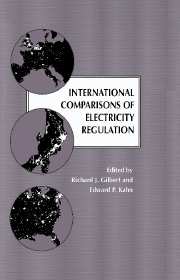Book contents
- Frontmatter
- Contents
- Preface
- International Comparisons of Electricity Regulation
- 1 Introduction: International comparisons of electricity regulation
- 2 Regulation, public ownership and privatisation of the English electricity industry
- 3 How should it be done? Electricity regulation in Argentina, Brazil, Uruguay, and Chile
- 4 From club-regulation to market competition in the Scandinavian electricity supply industry
- 5 Competition and institutional change in U.S. electric power regulation
- 6 The Japanese electric utility industry
- 7 Regulation of the market for electricity in the Federal Republic of Germany
- 8 The evolution of New Zealand's electricity supply structure
- 9 Regulation of electric power in Canada
- 10 The French electricity industry
- 11 The Yugoslav electric power industry
- Index
11 - The Yugoslav electric power industry
Published online by Cambridge University Press: 21 March 2010
- Frontmatter
- Contents
- Preface
- International Comparisons of Electricity Regulation
- 1 Introduction: International comparisons of electricity regulation
- 2 Regulation, public ownership and privatisation of the English electricity industry
- 3 How should it be done? Electricity regulation in Argentina, Brazil, Uruguay, and Chile
- 4 From club-regulation to market competition in the Scandinavian electricity supply industry
- 5 Competition and institutional change in U.S. electric power regulation
- 6 The Japanese electric utility industry
- 7 Regulation of the market for electricity in the Federal Republic of Germany
- 8 The evolution of New Zealand's electricity supply structure
- 9 Regulation of electric power in Canada
- 10 The French electricity industry
- 11 The Yugoslav electric power industry
- Index
Summary
Introduction
Yugoslavia came into existence after World War I, uniting two independent states (Serbia and Montenegro) and parts of Austria-Hungary consisting of South Slav populations (Slovenia, Bosnia-Hercegovina, and Croatia). Differences in the level of development among the regions were very large, including the extent of electrification. Territory in Istria, acquired following World War II, was relatively advanced with respect to electric power. By the end of the 1980s there were almost no differences in the level of electrification, though not in consumption of electric power, among the republics. Strengthening of the republics vis-à-vis the federation, however, along with unresolved political, national, and religious questions, led to division of the country in 1991. The analysis that follows attempts to show how the industry managed to achieve a remarkable record in spite of adverse conditions.
Growth of the electric power industry before World War II
Installations for generating electricity in what later became Yugoslavia appeared near the end of the nineteenth century. The first power station began operations in the Croatian town of Duga Resa in 1884, followed in 1888 by Slovenia (Litija), Bosnia-Hercegovina (Zenica), and Serbia (Belgrade) in 1892. The first three of these were made for industrial purposes, whereas the Belgrade station satisfied municipal needs. The Belgrade station had a capacity of 440 kW, and its generators were powered by three steam engines. Very quickly thereafter power stations were built in Zagreb, Ljubljana, and other large cities. They supplied direct current and relied on oil or high-quality coal for fuel. The first alternating current was supplied by a station built in 1899 on the river Djetina at Uzice in Serbia.
- Type
- Chapter
- Information
- International Comparisons of Electricity Regulation , pp. 457 - 491Publisher: Cambridge University PressPrint publication year: 1996



